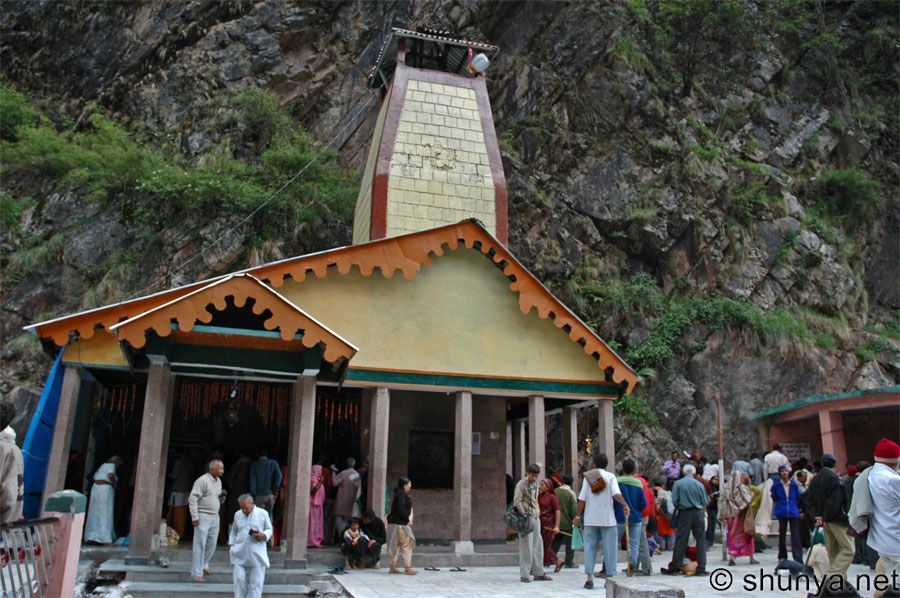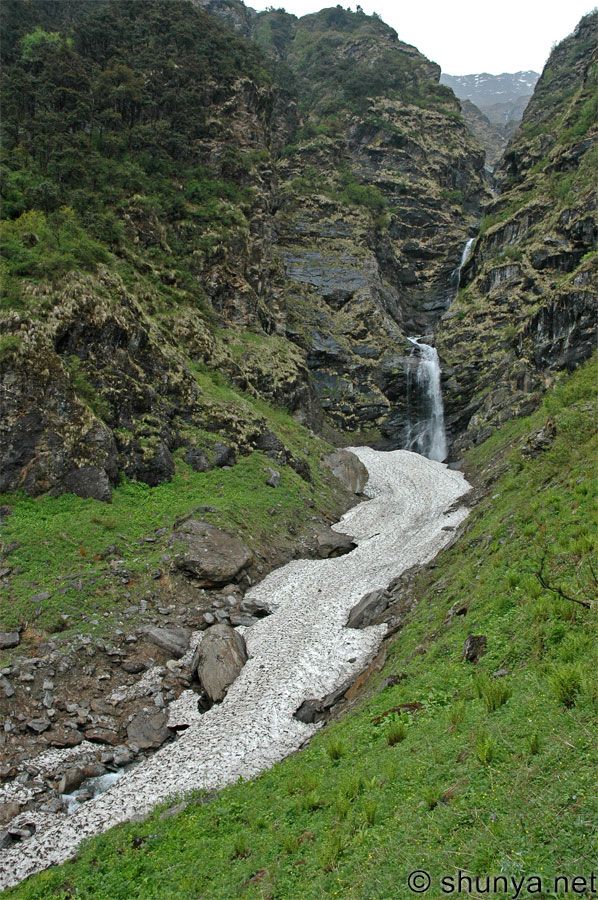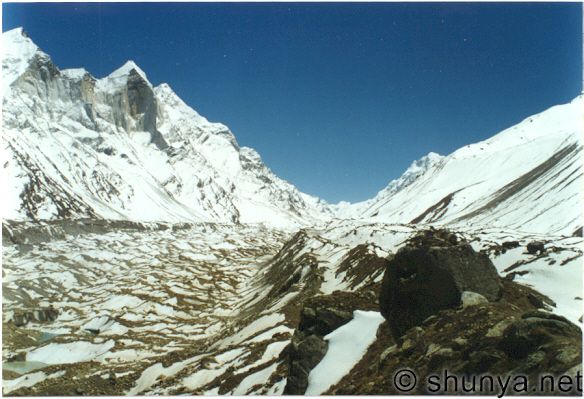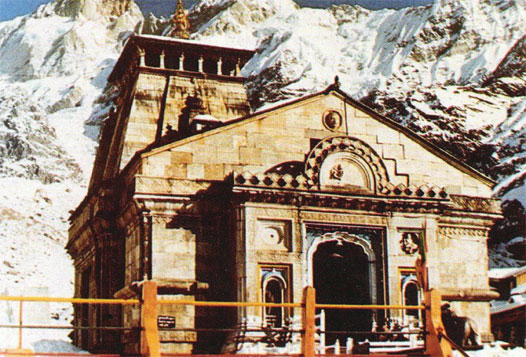 Char Dham is the most important Hindu pilgrimage circuit in the Indian Himalayas. Located in the Garhwal section of the state of Uttarakhand (formerly the northwestern section of Uttar Pradesh), the circuit consists of four sites—Yamunotri, Gangotri, Kedarnath , and Badrinath. While each site is unique in its own fashion, inclusion in the Char Dham has, over time, caused them be viewed together in popular imagination and actual pilgrimage practice.
Char Dham is the most important Hindu pilgrimage circuit in the Indian Himalayas. Located in the Garhwal section of the state of Uttarakhand (formerly the northwestern section of Uttar Pradesh), the circuit consists of four sites—Yamunotri, Gangotri, Kedarnath , and Badrinath. While each site is unique in its own fashion, inclusion in the Char Dham has, over time, caused them be viewed together in popular imagination and actual pilgrimage practice.
Yamunotri is a pilgrimage site near the source of the Yamuna, a river sacred to the Hindus. Hundreds of thousands go up the 6 km path each year from the settlement of Janaki Chatti. Most walk up but some get carried up by others. The hike culminates at the temple to the river goddess followed by a dip in the freshly melted waters of the Yamunotri glacier. Recent years have seen a sharp rise in the number of visitors due to package tourism and higher incomes of the great Indian lower and middle classes. They come from far and wide, driven by unexamined beliefs and a relationship to nature that - with its self-absorbed devotion and ignorance of the natural world - many postmodern atheists would consider an impoverishment. Yamunotri is the source of the river Yamuna. About 220 Km from Rishikesh and 149 Km from Tehri, the picturesque shrine of Yamunotri is located at an altitude of 3,235 m. Being one of the four Char dhams it is a place of paramount religious importance for the devout Hindus. The 19th century temple of Goddess Yamuna, a number of thermal springs and Divya Shila ( Rock pillar) are prime attractions. Moreover, the place is full with scenic spot and panoramic views of Himalayas. The current temple is of recent origin as past iterations have been destroyed by the weather and elements. Lodging at the temple itself is limited to a few small ashrams and guest-houses. Ritual duties such as the making and distribution of prasad (sanctified offerings) and the supervision of pujas(ritual venerations) are performed by the Uniyal family of pujaris (priests). Unique aspects of ritual practice at the site include hot springs where raw rice is cooked and made into prasad
About 220 Km from Rishikesh and 149 Km from Tehri, the picturesque shrine of Yamunotri is located at an altitude of 3,235 m. Being one of the four Char dhams it is a place of paramount religious importance for the devout Hindus. The 19th century temple of Goddess Yamuna, a number of thermal springs and Divya Shila ( Rock pillar) are prime attractions. Moreover, the place is full with scenic spot and panoramic views of Himalayas. The current temple is of recent origin as past iterations have been destroyed by the weather and elements. Lodging at the temple itself is limited to a few small ashrams and guest-houses. Ritual duties such as the making and distribution of prasad (sanctified offerings) and the supervision of pujas(ritual venerations) are performed by the Uniyal family of pujaris (priests). Unique aspects of ritual practice at the site include hot springs where raw rice is cooked and made into prasad
The shrine of Gangotri is situated at an elevation of 3048 m amidst captivating surroundings. Gangotri is located at a distance of 99 km from Uttarkashi. The temple, constructed by the Gorkha General Amar Singh Thapa, in the 18th century, is situated on the left bank of Bhagirathi. It is visited by lakhs of pilgrims every year. A number of ashrams are located on the other side, some of which provide accommodation facilities to the visitors. By November, Gangotri is covered by snow. It is believed that the Goddess retreats to Mukhba, her winter abode ( 12 kms downstream ).The physical source of the holy river is at Gaumukh, 18 kms. further uphill, along the Gangotri Glacier.  Several pilgrims trek upto the source to offer prayers either on foot or on ponies.The verdant valleys, dense forests and towering peaks offer excellent trekking and mountaineering opportunities for adventure enthusiasts. The picturesque pilgrimage in the hinterlands of the Himalayas is the most sacred spot where Ganga , the stream of life, touched earth for the first time.A
Several pilgrims trek upto the source to offer prayers either on foot or on ponies.The verdant valleys, dense forests and towering peaks offer excellent trekking and mountaineering opportunities for adventure enthusiasts. The picturesque pilgrimage in the hinterlands of the Himalayas is the most sacred spot where Ganga , the stream of life, touched earth for the first time.A  According to mythology, Goddess Ganga - the daughter of heaven, manifested herself in the form of a river to absolve the sins of King Bhagirath’s predecessors, following his severe penance of several centuries. Lord Shiva received into his matted locks to minimise the immense impact of her fall. She came to be called Bhagirathi at her legendary source.Ritual duties are supervised by the Semwal family of pujaris. The aarti ceremony at the Gangotri is especially impressive, as is the temple, a stately affair that sits on the banks of the rushing Ganga. Adventurous pilgrims can make an overnight 18 km trek to Gaumukh, the actual current source of the river Ganga.For a large number of tourists, Gangotri town serves as the starting point of the Gangotri-Gaumukh-Tapovan and Gangotri-Kedartal trekking routes.
According to mythology, Goddess Ganga - the daughter of heaven, manifested herself in the form of a river to absolve the sins of King Bhagirath’s predecessors, following his severe penance of several centuries. Lord Shiva received into his matted locks to minimise the immense impact of her fall. She came to be called Bhagirathi at her legendary source.Ritual duties are supervised by the Semwal family of pujaris. The aarti ceremony at the Gangotri is especially impressive, as is the temple, a stately affair that sits on the banks of the rushing Ganga. Adventurous pilgrims can make an overnight 18 km trek to Gaumukh, the actual current source of the river Ganga.For a large number of tourists, Gangotri town serves as the starting point of the Gangotri-Gaumukh-Tapovan and Gangotri-Kedartal trekking routes.
Amidst the dramatic mountainscapes of the majestic Kedarnath range stands one of the twelve ‘Jyotirlingas’ of Kedar or Lord Shiva. Lying at an altitude of 3584 mts. on the head of river Mandakini, the shrine of Kedarnath is amongst the holiest pilgrimages for the Hindus. The origin of the revered temple can be found in the great epic - Mahabharata. According to legend, the Pandavas sought the blessings of Lord Shiva to atone their sins after the battle of Mahabharata. Lord Shiva eluded them repeatedly and while fleeing took refuge at Kedarnath in the form of a bull. On being followed, HE dived into the ground, leaving behind HIS hump on the surface. This conical protrusion is worshipped as the idol in the shrine.The remaining portions of Lord Shiva are worshipped at four other places - the arms (bahu) at Tungnath, mouth (mukh) at Rudranath, navel (nabhi) at Madmaheshwar and hair (jata) at Kalpeshwar.
The origin of the revered temple can be found in the great epic - Mahabharata. According to legend, the Pandavas sought the blessings of Lord Shiva to atone their sins after the battle of Mahabharata. Lord Shiva eluded them repeatedly and while fleeing took refuge at Kedarnath in the form of a bull. On being followed, HE dived into the ground, leaving behind HIS hump on the surface. This conical protrusion is worshipped as the idol in the shrine.The remaining portions of Lord Shiva are worshipped at four other places - the arms (bahu) at Tungnath, mouth (mukh) at Rudranath, navel (nabhi) at Madmaheshwar and hair (jata) at Kalpeshwar. Together with Kedarnath, these places are known as the Panch Kedar.The lingam at Kedarnath is pyramidal, unlike its usual form. A status of Nandi – the celestial bull stands at the entrance of the temple and exquisitely carved images adorn the interiors of the temple.During the winters, the shrine is submerged in snow and hence is closed. The ideal time to visit is between May to October. Kedarnath is reached through a 14 km. long trek from Gaurikund.
Together with Kedarnath, these places are known as the Panch Kedar.The lingam at Kedarnath is pyramidal, unlike its usual form. A status of Nandi – the celestial bull stands at the entrance of the temple and exquisitely carved images adorn the interiors of the temple.During the winters, the shrine is submerged in snow and hence is closed. The ideal time to visit is between May to October. Kedarnath is reached through a 14 km. long trek from Gaurikund.  Kedarnath hosts one of the holiest Hindu temples and is a popular destination for Hindu pilgrims from all over the world. It is named after King Kedar who ruled in the Satya yuga. He ruled the seven continents and was a very saintly king. He had a daughter named Vrnda who was a partial incarnation of Goddess Lakshmi. She perfomed austerities for 60000 years. Because of her, the land is named Vrindavan.
Kedarnath hosts one of the holiest Hindu temples and is a popular destination for Hindu pilgrims from all over the world. It is named after King Kedar who ruled in the Satya yuga. He ruled the seven continents and was a very saintly king. He had a daughter named Vrnda who was a partial incarnation of Goddess Lakshmi. She perfomed austerities for 60000 years. Because of her, the land is named Vrindavan.
The holy temple of Badrinath, dedicated to Lord Vishnu, is siuated on the right bank of Vishnuganga in the middle of two mountain ranges called Nar and Narayan, rising east and west respectively. The place was known as Badrivan during Puranic times because it was found carpeted by wild Berries or 'Badri' and thus Badrivan.  The Badrinath temple was constructed and renovated by Shankaracharya some time in 8th century during his pilgrimage to Badrinath and Kedamath after he had established 'Jyotirdham' in Joshimath. There is a 'Tapt Kund' with hot water which has to be mixed with cold water before taking bath. Narada Kund, Surya Kund, Basudhara, Mata Murti and Charan Paduka are the other holy places of attraction for the large numDer of pilgrims who visit Badrinath every year. About 8 kms from Badrinath in the west, there is a group of snow peak called Choukhamba with height up to 6700 m.
The Badrinath temple was constructed and renovated by Shankaracharya some time in 8th century during his pilgrimage to Badrinath and Kedamath after he had established 'Jyotirdham' in Joshimath. There is a 'Tapt Kund' with hot water which has to be mixed with cold water before taking bath. Narada Kund, Surya Kund, Basudhara, Mata Murti and Charan Paduka are the other holy places of attraction for the large numDer of pilgrims who visit Badrinath every year. About 8 kms from Badrinath in the west, there is a group of snow peak called Choukhamba with height up to 6700 m.  There is another peak called Neelkantha about 9 km. south west of Badrinath.The temple of Badrinath is visited by about six lakh pilgrims every year. There is a plan to make a village complex for the pilgrims at an estimated cost of rupees one crore. Presently hotel Devlok has been constructed at Badrinath to provide board and lodging facilities to pilgrims. According to legend Shankara discovered a black stone image of Lord Badrinarayan made of Saligram stone in the Alaknanda River. He originally enshrined it in a cave near the Tapt Kund hot springs. In the sixteenth century, the King of Garhwal moved the murti to the present temple.The temple has undergone several major renovations because of age and damage by avalanche.In the 17th century, the temple was expanded by the kings of Garhwal.
There is another peak called Neelkantha about 9 km. south west of Badrinath.The temple of Badrinath is visited by about six lakh pilgrims every year. There is a plan to make a village complex for the pilgrims at an estimated cost of rupees one crore. Presently hotel Devlok has been constructed at Badrinath to provide board and lodging facilities to pilgrims. According to legend Shankara discovered a black stone image of Lord Badrinarayan made of Saligram stone in the Alaknanda River. He originally enshrined it in a cave near the Tapt Kund hot springs. In the sixteenth century, the King of Garhwal moved the murti to the present temple.The temple has undergone several major renovations because of age and damage by avalanche.In the 17th century, the temple was expanded by the kings of Garhwal. 

The Kedarnath temple is believed to have been built by Adi Sankaracharya and is one of the twelve Jyotirlingas, the holiest Hindu shrines of Shiva. The older temple existed from the times of Mahabharata, when the Pandavas are supposed to have pleased Shiva by doing penance in Kedarnath. The temple is also one of the four major sites in India’s Chota Char Dham pilgrimage of Northern Himalayas.